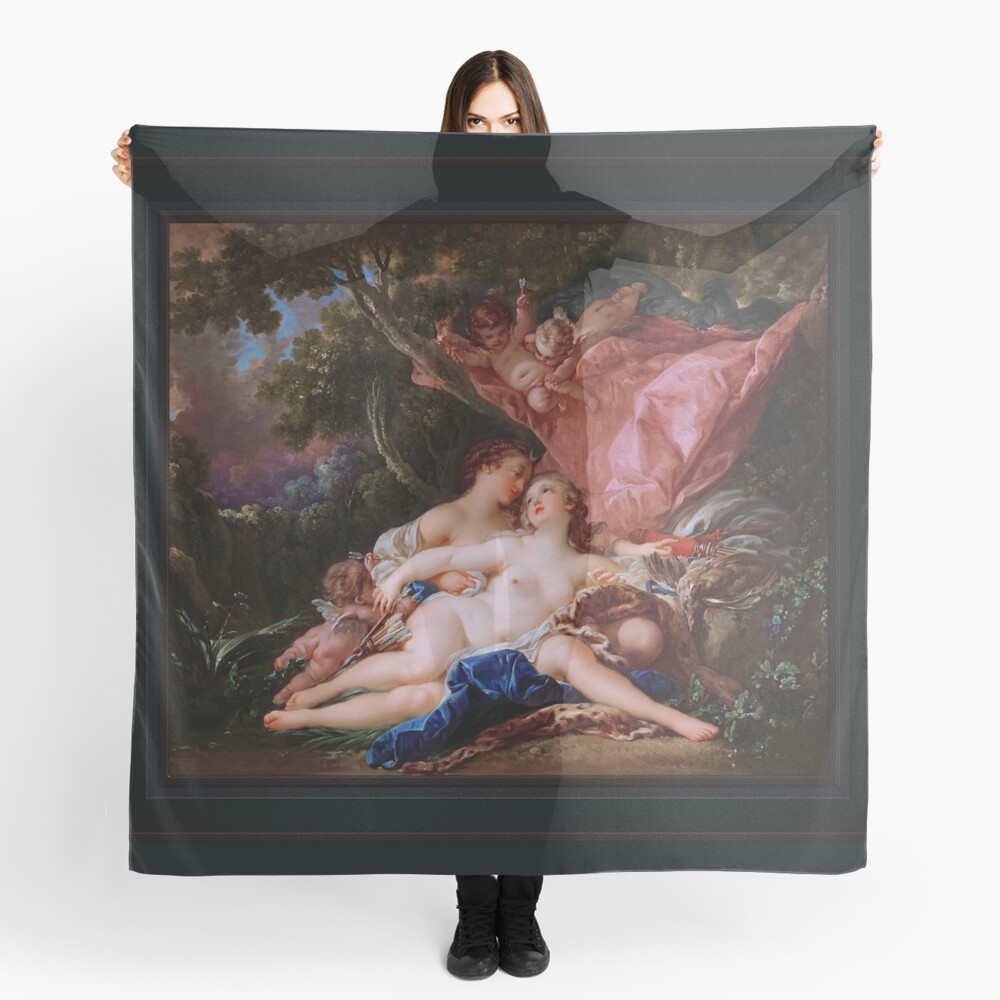
Jupiter in the Guise of Diana, and the Nymph Callisto
Jupiter in the Guise of Diana, and the Nymph Callisto c1759 by French Painter Francois Boucher (1703 – 1770); també conegut com a dibuixant, gravador i decorador a l'estil rococó francès, that was well known for his lavish mythological, motius al·legòrics i eròtics i va ser el pintor de la cort de Lluís XV i favorit de la marquesa de Pompadour.

This is a beautiful scene depicting the characters from Roman mythology Jupiter (The Eagle), Diana (Goddess of the Hunt), and Callisto the favorite Nymph of Diana.
In this forest scene we can see six figures, two cherubs in a tree with a large rose drape hanging from one of its outstretched limbs, near the eagle Jupiter looking down on what appears to be Diana and her Nymph Callisto, with one holding an arrow in his left hand; with another on the ground by the pond that Diana and her Nymph Callisto are laying near with an arrow in its left hand and a quiver filled with arrows by its right side.
Jupiter, the King of the Gods taken by the beauty of Callisto, disguises himself as the huntress Diana to seduce her; embracing her while they relax by the pond on a cushion of leaves, a blue garment and leopard skin.
By the couple is a boulder that has on it a brown bird resting on the chest of light colored bird that has had its throat cut, with blood staining the rock.
Behind the birds is a red quiver filled with arrows and a bow and another wrapped up grey colored garment, that rest just under the pink drape and the eagle Jupiter.

In the background is a colorful forest of many different hues and a light blue sky filled with many colored clouds, that seems to be illuminated by a setting sun.
Jupiter in the Guise of Diana, and the Nymph Callisto is a remastered digital art old masters reproduction of a public domain image that is available as a Impressió de tela en línia.
Informació a continuació derivada de Wikipedia.org
Natiu de París, Boucher era fill d'un pintor menys conegut Nicolas Boucher, que li va donar la seva primera formació artística. Als disset anys, un quadre de Boucher va ser admirat pel pintor François Lemoyne. Més tard, Lemoyne va nomenar Boucher com a aprenent, però després de només tres mesos, va anar a treballar per al gravador Jean-François Cars.
En 1720, va guanyar el Gran Premi d'elit de Roma de pintura, però no va aprofitar la conseqüent oportunitat per estudiar a Itàlia fins cinc anys després, per problemes econòmics de la Reial Acadèmia de Pintura i Escultura.[1] En tornar dels estudis a Itàlia va ser admès a la refundada Académie de peinture et de sculpture on 24 de novembre 1731. La seva peça de recepció (peça de recepció) va ser el seu Rinaldo i Armida de 1734.

Boucher es va casar amb Marie-Jeanne Buzeau a 1733. La parella va tenir tres fills junts. Boucher es va convertir en membre de la facultat 1734 i la seva carrera es va accelerar a partir d'aquest punt, ja que va ser ascendit a Professor i després Rector de l'Acadèmia, esdevenint inspector de la Royal Gobelins Manufactory i finalment Premier Peintre du Roi (Primer Pintor del Rei) dins 1765. Retrat de Marie-Louise O'Murphy c. 1752
Boucher va morir 30 maig 1770 al seu París natal. El seu nom, juntament amb la de la seva patrona Madame de Pompadour, s'havia convertit en sinònim de l'estil rococó francès, conduint els germans Goncourt a escriure: “Boucher és un d'aquells homes que representen el gust d'un segle, que expressen, personificar-lo i encarnar-lo.”
Boucher és famós per dir que la natura ho és “massa verd i poc il·luminat” (massa verd i mal il·luminat).
Boucher estava associat amb el gravador de pedres precioses Jacques Guay, a qui va ensenyar a dibuixar. També va ser mentor del pintor moràu-austríac Martin Ferdinand Quadal així com del pintor neoclàssic Jacques-Louis David a 1767.[4] Més tard, Boucher va fer una sèrie de dibuixos d'obres de Guay que Madame de Pompadour va gravar i va distribuir com un volum ben enquadernat als cortesans preferits.



